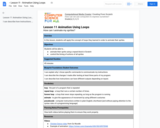
In this lesson, students will apply the concept of loops they learned in order to animate their sprites.
- Subject:
- Applied Science
- Computer Science
- Material Type:
- Activity/Lab
- Author:
- NYC Computer Science for All
- Date Added:
- 06/10/2021

In this lesson, students will apply the concept of loops they learned in order to animate their sprites.

Introduction to animation using costumes in Scratch
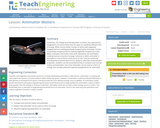
Antimatter, the charge reversed equivalent of matter, has captured the imaginations of science fiction fans for years as a perfectly efficient form of energy. While normal matter consists of atoms with negatively charged electrons orbiting positively charged nuclei, antimatter consists of positively charged positrons orbiting negatively charged anti-nuclei. When antimatter and matter meet, both substances are annihilated, creating massive amounts of energy. Instances in which antimatter is portrayed in science fiction stories (such as Star Trek) are examined, including their purposes (fuel source, weapons, alternate universes) and properties. Students compare and contrast matter and antimatter, learn how antimatter can be used as a form of energy, and consider potential engineering applications for antimatter.
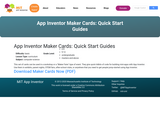
This set of cards can be used in a workshop or a "Maker Faire" type of event. They give quick tidbits of code for building mini-apps with App Inventor. Use them in exhibits, parent nights, STEM fairs, after-school clubs, or anywhere that you need to get people jump-started using App Inventor.
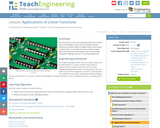
This final lesson in the unit culminates with the Go Public phase of the legacy cycle. In the associated activities, students use linear models to depict Hooke's law as well as Ohm's law. To conclude the lesson, students apply they have learned throughout the unit to answer the grand challenge question in a writing assignment.
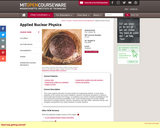
Fundamentals of nuclear physics for engineering students. Basic properties of the nucleus and nuclear radiations. Elementary quantum mechanical calculations of bound-state energies and barrier transmission probability. Binding energy and nuclear stability. Interactions of charged particles, neutrons, and gamma rays with matter. Radioactive decays. Energetics and general cross-section behavior in nuclear reactions.
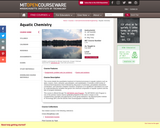
This course details the quantitative treatment of chemical processes in aquatic systems such as lakes, oceans, rivers, estuaries, groundwaters, and wastewaters. It includes a brief review of chemical thermodynamics that is followed by discussion of acid-base, precipitation-dissolution, coordination, and reduction-oxidation reactions. Emphasis is on equilibrium calculations as a tool for understanding the variables that govern the chemical composition of aquatic systems and the fate of inorganic pollutants.
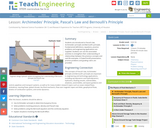
Students are introduced to Pascal's law, Archimedes' principle and Bernoulli's principle. Fundamental definitions, equations, practice problems and engineering applications are supplied. A PowerPoint® presentation, practice problems and grading rubric are provided.
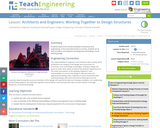
Students explore the interface between architecture and engineering. In the associated hands-on activity, students act as both architects and engineers by designing and building a small parking garage.
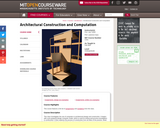
This class investigates the use of computers in architectural design and construction. It begins with a pre-prepared design computer model, which is used for testing and process investigation in construction. It then explores the process of construction from all sides of the practice: detail design, structural design, and both legal and computational issues.
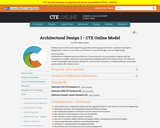
Architectural and Structural Engineering provides learning opportunities for students interested in preparing for careers in such areas as architecture, industrial design, and civil engineering.
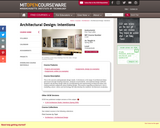
" This is the second undergraduate design studio. It introduces a full range of architectural ideas and issues through drawing exercises, analyses of precedents, and explored design methods. Students will develop design skills by conceptualizing and representing architectural ideas and making aesthetic judgments about building design. Discussions regarding architecture's role in mediating culture, nature and technology will help develop the students' architectural vocabulary."
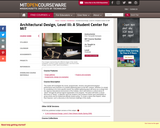
" This studio will investigate the social, programmatic, tectonic and phenomenological performance and character of a student gathering place on the MIT campus. Whether it is simply for socializing or for more specific events, the student gathering place will serve as a refuge from the vigorous educational environment of the Institute, and it will reinforce a critical sense of "place" through the almost logical organization of its program. The place will foster a casual discovery of "being": a reflection upon the student's own existence based upon participation in group events and an intellectual attitude toward acting. To create a space that inspires, rather than imposes: such a discovery is the foremost challenge of this studio."

This semester students are asked to transform the Hereshoff Museum in Bristol, Rhode Island, through processes of erasure and addition. Hereshoff Manufacturing was recognized as one of the premier builders of America's Cup racing boats between 1890's and 1930's. The studio however, is about more then the program. It is about land, water, and wind and the search for expressing materially and tectonically the relationships between these principle conditions. That is, where the land is primarily about stasis (docking, anchoring and referencing our locus), water's fluidity holds the latent promise of movement and freedom. Movement is activated by wind, allowing for negotiating the relationship between water and land.
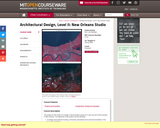
The project for this studio is to design a demonstration project for a site near the French Quarter in New Orleans. The objectives of the project are the following: To design more intense housing, community, educational and commercial facilities in 4 to 6 story buildings. To explore the "space between" buildings as a way of designing and shaping objects. To design at three scales - dwelling, cluster and overall. To design dwellings where the owners may be able to help build and gain a skill for employment. To provide/design facilities that can help the residents to gain education and skills.

Establishes basic attitudes toward architectural organization and its reflection in form. Includes projects where imposed conditions of site, program, and building system emphasize the interrelationship of fundamental elements in the pattern of decision-making that constitutes architectural design. Develops presentations through drawings and models. Intended for entering M.Arch. students. Course Description This studio explores the notion of in-between by engaging several relationships; the relationship between intervention and perception, between representation and notation and between the fixed and the temporal. In the Exactitude in Science, Jorge Luis Borges tells the perverse tale of the one to one scale map, where the desire for precision and power leads to the escalating production of larger and more accurate maps of the territory. For Jean Baudrillard, "The territory no longer precedes the map nor survives it. ĺÉit is the map that precedes the territory... and thus, it would be the territory whose shreds are slowly rotting across the map." The map or the territory, left to ruin-shredding across the 'other', beautifully captures the tension between reality and representation. Mediating between collective desire and territorial surface, maps filter, create, frame, scale, orient, and project. A map has agency. It is not merely representational but operational, the experience and discursive potential of this process lies in the reciprocity between the representation and the real. It is in-between these specific sets of relationships that this studio positions itself.

This class investigates the theory, method, and form of collage. It studies not only the historical precedents for collage and their physical attributes, but the psychology and process that plays a part in the making of them. The class was broken into three parts, changing scales and methods each time, to introduce and study the rigor by which decisions were made in relation to the collage. The class was less about the making of art than the study of the processes by which art is made.
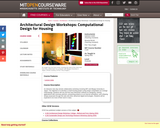
An intensive 9 DAY remote collaborative workshop involving MIT and Miyagi University in Japan. The objective is to develop a small housing project using shape computation as a design methodology. Students will use and test new interactive software for designing, sharing applications with overseas partners, presenting projects on an Internet workspace, and critiquing design proposals through the web and other advanced digital technologies. Students will be expected to do most of their work in class.
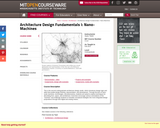
This is the second undergraduate architecture design studio, which introduces design logic and skills that enable design thinking, representation, and development. Through the lens of nano-scale machines, technologies, and phenomena, students are asked to explore techniques for describing form, space, and architecture. Exercises encourage various connotations of the "machine" and challenge students to translate conceptual strategies into more integrated design propositions through both digital and analog means.
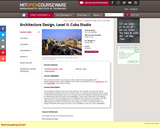
This architectural studio will have one main project for the semester: to explore the issues surrounding the redesign of an area in Havana Cuba. It is a typical area about the size of a Law of Indies block that presently has a mix of housing, work, and shopping in buildings that need to be replaced and others that need to be rehabilitated. There is also vacant land, and buildings that are unused. Part of the blocks front on the Malecon, the street next to the water. The other edge fronts onto a typical neighborhood. The intention is to study the culture through an understanding of one area of Havana and then design an "echo" in architectural form. The design will include public space as well as a mix of buildings: some new, some rehabilitated.